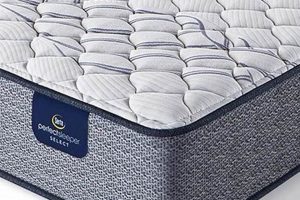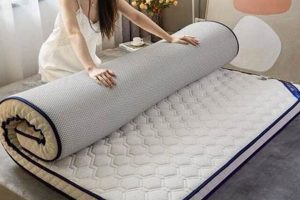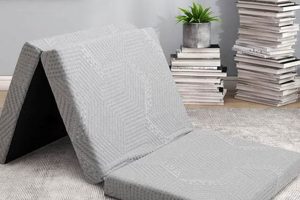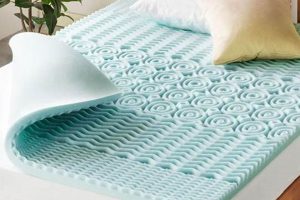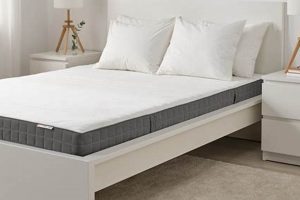The duration required for a memory foam mattress to reach its full size after unboxing is a common consideration for consumers. This timeframe represents the period necessary for the compressed foam material to decompress and achieve its intended shape and firmness. Several factors can influence this process, impacting user expectations and satisfaction.
Understanding this expansion period is important for optimal sleep quality and mattress longevity. A mattress that has not fully expanded may not provide the correct support, potentially leading to discomfort or affecting spinal alignment. Historically, this characteristic has been a significant aspect of consumer education related to memory foam products, distinguishing them from traditional innerspring mattresses.
Factors such as ambient temperature, mattress density, and compression method during shipping play a role in the complete expansion. Therefore, understanding these elements allows for better preparation and management of the unboxing and setup process.
Tips for Optimizing Mattress Expansion
The following recommendations provide guidance on promoting complete and timely expansion of a memory foam mattress following its removal from packaging.
Tip 1: Unbox Promptly: Remove the mattress from its packaging as soon as it arrives. Prolonged compression can impede the foam’s ability to fully recover its intended shape.
Tip 2: Ensure Adequate Ventilation: Place the mattress in a well-ventilated room. Fresh air circulation assists in the dissipation of any residual odors from the manufacturing process and promotes faster expansion.
Tip 3: Maintain Ideal Room Temperature: Memory foam responds to temperature. A room temperature between 68-72F (20-22C) is generally considered optimal for facilitating expansion.
Tip 4: Allow Sufficient Time: While some mattresses may expand within 24 hours, allow up to 72 hours for full expansion. Thicker or denser mattresses may require the longer timeframe.
Tip 5: Monitor Expansion Evenly: Observe the mattress periodically to ensure it is expanding uniformly across all areas. If discrepancies are noted, consult the manufacturer’s instructions.
Tip 6: Provide a Flat Surface: Ensure the mattress rests on a flat, supportive foundation during expansion. This prevents uneven pressure and supports proper shape reformation.
Following these guidelines assists in maximizing the performance and comfort of the memory foam mattress. By optimizing the expansion process, the user ensures they receive the intended support and pressure relief benefits.
The ensuing sections will delve into the various factors impacting expansion time in greater detail, furnishing a thorough comprehension of the subject.
1. Density
Density, a fundamental characteristic of memory foam, directly correlates with the duration required for a mattress to fully expand. This relationship is governed by the material’s inherent properties and its response to compression and decompression processes.
- Material Resistance
Higher density foam exhibits increased resistance to expansion due to its tighter cell structure. This structure inherently reduces the speed at which air can permeate the material, thus prolonging the expansion phase after unboxing. The increased material also provides a stronger physical barrier which reduces the rate of expansion.
- Compression Duration Impact
Density influences the degree to which prolonged compression impacts expansion. A higher density foam, when compressed for an extended period, experiences a greater degree of structural deformation. Consequently, it requires a more extended timeframe to revert to its original, uncompressed state. The duration of compression also influences this behavior, further elongating the time to full expansion.
- Temperature Sensitivity
The density of memory foam amplifies its temperature sensitivity concerning expansion. Lower temperatures cause the foam to stiffen, increasing resistance to expansion, particularly in high-density materials. Conversely, warmer temperatures facilitate expansion, but this effect is less pronounced in denser foams due to their inherent structural integrity.
- Weight Support and Recovery
A mattress with higher density foam generally offers greater weight support and enhanced durability. However, this increased support comes at the cost of a longer initial expansion phase. The foam must overcome its inherent resistance to achieve its optimal shape and provide the intended level of support. Over time, high density foam tends to recover more slowly, but completely, from compression.
In summary, density plays a pivotal role in dictating the duration needed for a memory foam mattress to fully expand. Its influence is multifaceted, affecting material resistance, compression duration impact, temperature sensitivity, and weight support recovery. Understanding these aspects allows consumers to make informed decisions regarding mattress selection and manage expectations concerning the initial setup process.
2. Temperature
Ambient temperature exerts a considerable influence on the rate at which a memory foam mattress expands. Memory foam’s viscoelastic properties are inherently temperature-sensitive. Lower temperatures cause the foam to stiffen, increasing its resistance to expansion and prolonging the time needed to reach its intended shape. Conversely, higher temperatures soften the foam, facilitating a quicker expansion. For instance, a mattress unboxed in a room with a temperature of 60F (15.5C) might take significantly longer to fully expand compared to an identical mattress unboxed in a room at 75F (24C). This difference arises from the foam’s increased elasticity at higher temperatures, allowing it to more readily regain its original form.
The practical significance of this temperature dependence is substantial for consumers. During colder months, it is advisable to increase the room temperature slightly to encourage faster and more complete expansion. This can be achieved through the use of space heaters or by ensuring adequate central heating. Conversely, during warmer periods, excessive heat should be avoided, as it may lead to temporary softening of the foam beyond its optimal density, potentially affecting initial comfort levels. Moreover, manufacturers often recommend a specific temperature range for optimal expansion, typically between 68F and 72F (20C to 22C), which highlights the importance of maintaining a controlled environment.
In conclusion, temperature stands as a critical factor in the expansion process of memory foam mattresses. Its impact stems from the inherent material properties of memory foam and its susc
eptibility to temperature-induced changes in elasticity. Acknowledging and managing temperature levels allows consumers to optimize the expansion process, ensuring they achieve the intended comfort and support characteristics of the mattress within a reasonable timeframe. This understanding mitigates potential frustrations associated with prolonged expansion periods and promotes a more satisfactory initial experience.
3. Thickness
Thickness directly impacts the duration required for a memory foam mattress to fully expand. The volume of foam present in thicker mattresses necessitates a longer period to decompress and achieve its intended form, influencing overall user readiness.
- Core Expansion Time
A thicker mattress possesses a larger volume of compressed foam within its core. This increased material requires a longer time to fully decompress compared to thinner mattresses. For instance, a 12-inch mattress invariably takes longer than an 8-inch mattress, assuming similar density and composition, due to the increased internal pressure resulting from compression.
- Layer Integration
Thicker mattresses often incorporate multiple layers of foam, each potentially with varying densities and properties. These layers expand at different rates, requiring time for complete integration. The differential expansion rates between layers can delay the overall expansion, particularly if adhesive bonding inhibits independent movement.
- Edge Support Considerations
The edge support system in a thicker mattress contributes to the overall expansion time. Reinforced edges, designed to prevent sagging, add structural resistance that slows decompression along the perimeter. This effect may lead to uneven expansion if the center of the mattress expands more rapidly than the edges initially.
- Compression Uniformity
During manufacturing and packaging, ensuring uniform compression becomes more challenging with increasing mattress thickness. Non-uniform compression can lead to varying expansion rates across the mattress surface. Areas with greater initial compression will require more time to fully decompress, contributing to an extended overall expansion period.
In summation, mattress thickness significantly influences the duration needed for complete expansion. Core expansion time, layer integration, edge support considerations, and compression uniformity all contribute to this extended timeframe. Comprehending these relationships enables consumers to manage their expectations and adequately prepare for the setup process associated with thicker memory foam mattresses.
4. Ventilation
Ventilation plays a crucial, often underestimated, role in the expansion rate of memory foam mattresses. Proper air circulation around the mattress facilitates the decompression process, influencing the time it takes for the foam to regain its intended shape and firmness.
- Off-Gassing Dissipation
Memory foam can emit volatile organic compounds (VOCs), a process known as off-gassing. Adequate ventilation accelerates the dissipation of these compounds, preventing their accumulation within the mattress and promoting a healthier sleep environment. While not directly impacting expansion time, dissipating these compounds can create the perception of faster readiness, as the mattress is considered usable sooner.
- Air Permeability Enhancement
Memory foam’s closed-cell structure can impede airflow. Ventilation encourages greater air permeability within the mattress, allowing the compressed foam cells to expand more readily. Improved airflow helps normalize the pressure differential between the compressed cells and the surrounding environment, facilitating quicker and more uniform expansion.
- Temperature Regulation Contribution
As previously discussed, temperature significantly affects expansion. Ventilation assists in maintaining a consistent temperature gradient throughout the mattress, preventing localized areas of slower expansion due to temperature variations. Proper ventilation prevents heat buildup, particularly in warmer environments, ensuring uniform expansion across the mattress surface.
- Moisture Management Support
Ventilation aids in moisture management within the mattress. Trapped moisture can hinder foam expansion and create an environment conducive to microbial growth. By promoting airflow, ventilation helps evaporate excess moisture, preserving the foam’s integrity and promoting efficient expansion. This indirectly contributes to the perception of readiness as the mattress is less likely to retain a damp or compressed feel.
In summary, the impact of ventilation on expansion is multifaceted. By facilitating off-gassing dissipation, enhancing air permeability, contributing to temperature regulation, and supporting moisture management, proper ventilation positively influences the overall expansion timeline and perceived readiness of a memory foam mattress. Failing to provide adequate ventilation may prolong the expansion process and compromise the initial user experience.
5. Compression
Compression, an inherent aspect of memory foam mattress distribution, exerts a direct influence on the duration required for complete expansion. The extent and duration of compression during packaging, shipping, and storage significantly affect the foam’s ability to return to its original dimensions. Mattresses subjected to prolonged compression typically exhibit a longer expansion period due to the deformation of the foam’s cellular structure. For example, a mattress compressed for several months in a warehouse before shipment will likely require more time to fully expand compared to one compressed for only a few days. This relationship underscores the importance of considering compression history when evaluating expansion timelines.
The method of compression also contributes to the expansion timeline. Mattresses that are tightly rolled and compressed using specialized machinery experience a higher degree of cellular deformation than those subjected to gentler compression methods. This increased deformation necessitates a longer period for the foam cells to regain their original shape and resilience. The practical significance of understanding this connection lies in managing consumer expectations. Retailers and manufacturers should transparently communicate potential expansion times, taking into account the compression method and duration. This proactive approach can mitigate customer dissatisfaction arising from delayed expansion and ensure a positive initial experience with the product.
In summary, compression is a critical determinant of the expansion timeline for memory foam mattresses. The degree and duration of compression, coupled with the method employed, directly impact the foam’s cellular structure and its capacity to recover its original dimensions. Comprehending this relationship enables effective communication with consumers, manages expectations, and ultimately contributes to enhanced customer satisfaction. Overcoming the challenges posed by prolonged or excessive compression requ
ires advancements in foam technology and optimized compression techniques aimed at minimizing cellular deformation and accelerating expansion.
6. Composition
The composition of a memory foam mattress is a primary determinant of the duration required for it to fully expand after unboxing. The specific materials utilized, their densities, and the layering configuration directly influence the rate at which the mattress regains its intended shape and firmness. Understanding these compositional elements is crucial for predicting expansion timelines and managing consumer expectations.
- Foam Density and Type
The density and type of memory foam used are key factors. Higher-density foams generally expand more slowly than lower-density foams due to their tighter cellular structure, as previously established. Furthermore, different formulations of memory foam, such as traditional viscoelastic foam versus newer gel-infused or plant-based foams, possess varying expansion characteristics. Gel-infused foams, for instance, may exhibit a slightly slower expansion rate due to the presence of the gel particles, which can impede airflow within the foam matrix. The specific polymers and additives employed in the foam formulation also contribute to the overall expansion timeline.
- Layering Configuration
The arrangement and thickness of different foam layers within the mattress significantly impact expansion. A mattress with multiple layers of varying densities and compositions will require more time to fully expand compared to a simpler, single-layer design. The differential expansion rates of the individual layers necessitate a period of adjustment and integration before the mattress achieves its final shape and support characteristics. Interlayer adhesives can also play a role, potentially restricting individual layer movement and prolonging the overall expansion process.
- Cover Material
The type of fabric used for the mattress cover influences ventilation and, consequently, expansion. A breathable cover material, such as cotton or bamboo, promotes airflow and accelerates the expansion process. Conversely, a less breathable cover material, such as certain synthetic fabrics, can impede airflow and prolong expansion. The cover’s tightness and elasticity also affect the foam’s ability to fully decompress. A tightly woven, non-elastic cover may restrict the foam’s expansion, requiring a longer timeframe to achieve its intended dimensions.
- Support Core Material
The composition of the support core, which typically lies beneath the memory foam layers, also contributes to the overall expansion time. Support cores made of high-density polyurethane foam or innerspring coils offer varying levels of resistance to compression and decompression. A denser support core may exert greater pressure on the memory foam layers, slowing their expansion. Conversely, a more flexible support core may allow for more rapid and uniform expansion. The interaction between the support core and the memory foam layers is a crucial determinant of the final expansion timeline.
In conclusion, the composition of a memory foam mattress, encompassing the type and density of foam, the layering configuration, the cover material, and the support core, collectively determines the rate at which the mattress expands. A comprehensive understanding of these compositional elements enables manufacturers to optimize mattress design for faster expansion and allows consumers to make informed purchasing decisions based on their expectations and preferences.
Frequently Asked Questions
The following addresses common inquiries regarding the duration required for a memory foam mattress to achieve its full size following unboxing.
Question 1: What is the typical expansion timeframe for a memory foam mattress?
Most memory foam mattresses require between 24 and 72 hours to fully expand. However, certain models may require longer periods depending on factors such as density and ambient temperature.
Question 2: What factors influence the speed at which a memory foam mattress expands?
Key factors include the density of the foam, the thickness of the mattress, the ambient temperature of the room, and the duration the mattress remained compressed during shipping and storage.
Question 3: Is it safe to sleep on a memory foam mattress before it has fully expanded?
While generally safe, it is advisable to allow the mattress to fully expand before use to ensure optimal support and comfort. Sleeping on a partially expanded mattress may compromise spinal alignment and pressure relief.
Question 4: Can the expansion process be expedited?
Maintaining a room temperature between 68-72F (20-22C) and ensuring adequate ventilation can assist in accelerating the expansion process. Removing all packaging immediately upon arrival is also recommended.
Question 5: What should be done if a memory foam mattress fails to fully expand within the expected timeframe?
Consult the manufacturer’s instructions or contact customer support for assistance. Factors such as prolonged compression or manufacturing defects may contribute to incomplete expansion. Providing photographic evidence can expedite the troubleshooting process.
Question 6: Does the expansion time affect the mattress’s long-term performance or lifespan?
The initial expansion process does not typically impact the long-term performance or lifespan of a memory foam mattress, provided the mattress is allowed to fully expand before regular use. However, incomplete initial expansion may affect the initial comfort and support characteristics.
These answers provide a foundational understanding of memory foam mattress expansion. Consulting specific product information and manufacturer guidelines remains essential for individual circumstances.
The subsequent section will address troubleshooting common expansion-related issues.
Determining Expansion Duration
This exploration of the phrase “how long does a memory foam mattress take to expand” has underscored the multifaceted nature of this process. Factors such as foam density, ambient temperature, mattress thickness, ventilation, compression history, and material composition collectively influence the expansion timeline. A comprehensive understanding of these variables equips consumers with the knowledge to manage expectations and optimize the setup process.
Continued research and technological advancements in foam manufacturing and compression techniques hold the potential to minimize expansion times and enhance initial user experiences. Further investigation into material science and optimized packaging methods remains crucial for improving product performance and consumer satisfaction in the memory foam mattress industry.


